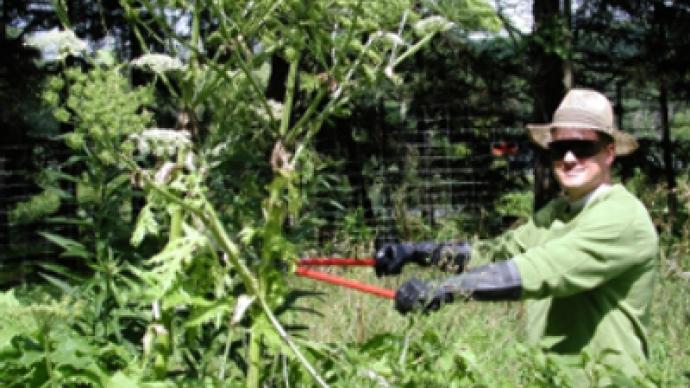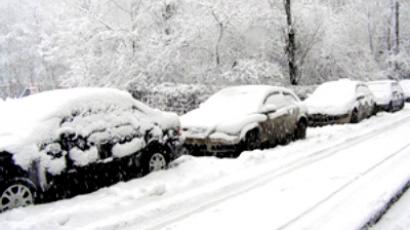Giant Hogweed invades Russia, spreading to America

Lawn lovers beware! An aggressive and toxic weed has reared its ugly head in Russia and threatens to make landfall at a manicured yard near you
Just outside of Moscow, alongside railroad tracks, rivers and streams, visitors may be astounded to see the infestation of a weed that for American gardeners and botanists has become the leafy equivalent of Osama bin Laden. Indeed, perhaps only poison ivy arouses more irritated animosity than the unlovable Giant Hogweed, which ranks on the U.S. federal noxious weed list as a “potential health hazard.”
Even for amateur green thumbs, the super weed, which has been called "Queen Anne’s on steroids," is unmistakable.
The Giant Hogweed (Heracleum mantegazzianum), which can grow up to 6 meters (about 20 feet) easily towers over the average NBA basketball player. It has a purple stalk that can grow to 3-8 centimeters in diameter (1.1 – 3.1 inches). Its deeply incised, dark-green leaves can grow between 1 and 1.5 meters (3.2 – 4.9 feet). At the very top of the weed, alien-looking umbrella-shaped pods spread out, giving the plant an almost menacing appearance. But if the Giant Hogweed’s looks won’t kill you, then its sting just might.
“Giant Hogweed exudes a clear, watery sap that causes the skin to become photosensitive to ultraviolet radiation,” warns Don R. Robbins in the Maryland Invasive Species website. “Contact with the sap can result in severe burns, blisters and dermatitis, possibly leading to future complications, namely skin cancer.”
In Russia, there seems to be less public hysteria over the presence of the weed, which seems to expand its range every summer, and there is no official plan to eradicate the plant. Indeed, given the preponderance of Hogweed in Russia, it is surprising how much attention a single sighting of the weed generates in the United States, where the plant is still a rare find. With all the hysterical media attention accorded to a deadly flu outbreak, Reuters reported the infernal plant was spotted this summer in Butler Country, Pennsylvania.
“Thanks to a tip on the Giant Hogweed hotline, the department was able to quickly and accurately identify the infestation,” Agricultural Secretary Dennis Wolffe told the news agency. “We encourage residents to stay away from the infested area as treatment continues, and to report any new sightings so we can act swiftly to stop the spread of the weed.”
U.S. residents are encouraged to call their local environmental agency on a special hotline number if they come in contact with the weed.
From what alien planet did this unholy weed arrive?
The Giant Hogweed is a native of the Caucasus Mountains, to the south of Russia, and before it turned into public enemy number one was used to adorn British gardens as a curiosity and conversation piece.
“Giant Hogweed was first introduced into the UK from its original habitat in the Caucasus region during the Victorian period as an ornamental plant,” reports Sustainable Solutions magazine. “The first record of Giant Hogweed in the UK was at the Kew Botanic Gardens in 1817 and the first naturalized population… was identified in Cambridgeshire in 1828.”
Today, the highly unaesthetic weed is the subject of the UK’s Wildlife and Countryside Act (1981), which states “It is an offense to plant or otherwise cause the Giant Hogweed to grow in the wild. Breaching the… Act could result in criminal prosecution.”
The weed has a slightly better reputation in other places, such as Iran, where the fruit is used to produce a specific spice known as golmar.
Although it is a bit easier to understand how the weed became ubiquitous across the temperate regions of Russia given its proximity to the Caucasus, the weed owes much of its notorious rise to former Soviet leader Joseph Stalin.
In search of a reliable source of food for livestock, Soviet agriculturists took their chances with Giant Hogweed, probably because it resembles very big cow parsnip. The results proved dismal, as the weed made the cow milk bitter to the point of undrinkable. In Soviet-era Poland, the order to import Giant Hogweed as cattle feed has won the weed the name “Stalin’s revenge.”
What to do with a Giant Hogweed?
Unless you are a Persian chef, or a horticulturist working under laboratory conditions, you probably don’t want a 15-foot Giant Hogweed hanging around your house. So how do you approach this toxic weed?
Experts seem to disagree on the best way to “eradicate” the noxious weed. One school of thought recommends keeping the weed mowed year round, thus preventing its seeds from reaching maturation. It probably goes without saying that protecting the all areas of exposed skin, including the eyes, is important.
The problem with Giant Hogweed seems to be in the durability of the seeds, which have been known to pop up almost 10 years later. The roots are also tough, so it is advisable to chop them up and dispose of them (most countries have very strict guidelines for removing the weed, so it is better to contact your local environmental agency, or landscaper for professional advice).
Another method of eradication involves pesticides, which gives the gardener the advantage of not going anywhere near this weed.
A last word of advice and this comes from the voice of experience (thankfully not first-hand): When looking for some relief in the Russian forest, be very careful what leaf you grab for. It may just be the leaf of the wicked Giant Hogweed.














